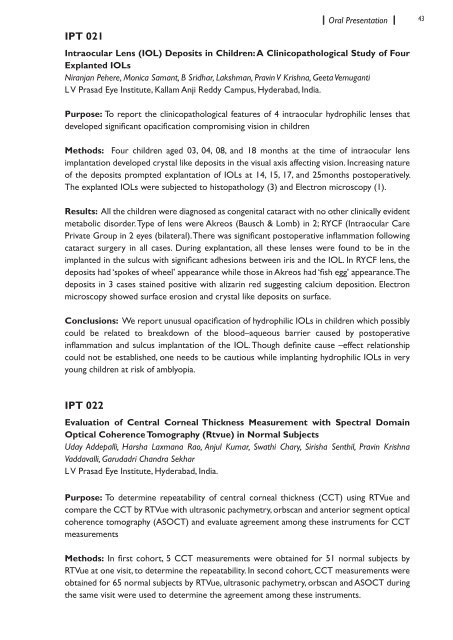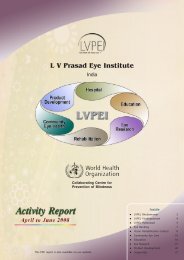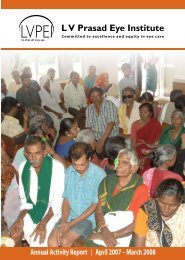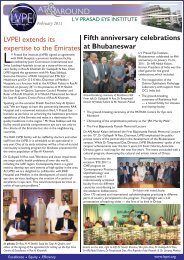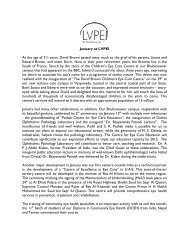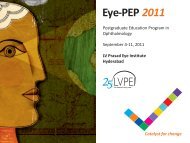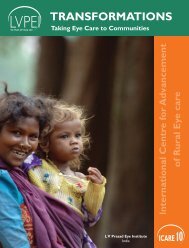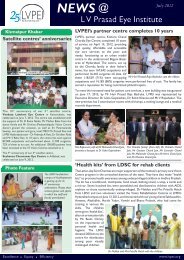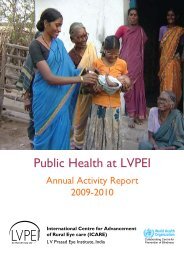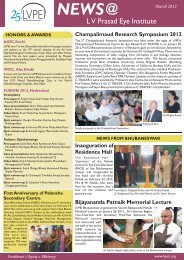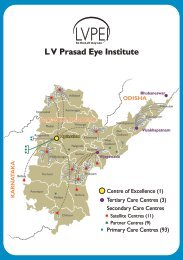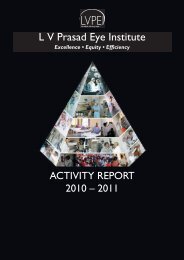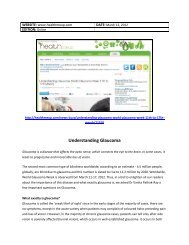IERG Abstracrt Book.indd - LV Prasad Eye Institute
IERG Abstracrt Book.indd - LV Prasad Eye Institute
IERG Abstracrt Book.indd - LV Prasad Eye Institute
You also want an ePaper? Increase the reach of your titles
YUMPU automatically turns print PDFs into web optimized ePapers that Google loves.
IPT 021Oral Presentation43Intraocular Lens (IOL) Deposits in Children: A Clinicopathological Study of FourExplanted IOLsNiranjan Pehere, Monica Samant, B Sridhar, Lakshman, Pravin V Krishna, Geeta VemugantiL V <strong>Prasad</strong> <strong>Eye</strong> <strong>Institute</strong>, Kallam Anji Reddy Campus, Hyderabad, India.Purpose: To report the clinicopathological features of 4 intraocular hydrophilic lenses thatdeveloped significant opacification compromising vision in childrenMethods: Four children aged 03, 04, 08, and 18 months at the time of intraocular lensimplantation developed crystal like deposits in the visual axis affecting vision. Increasing natureof the deposits prompted explantation of IOLs at 14, 15, 17, and 25months postoperatively.The explanted IOLs were subjected to histopathology (3) and Electron microscopy (1).Results: All the children were diagnosed as congenital cataract with no other clinically evidentmetabolic disorder. Type of lens were Akreos (Bausch & Lomb) in 2; RYCF (Intraocular CarePrivate Group in 2 eyes (bilateral). There was significant postoperative inflammation followingcataract surgery in all cases. During explantation, all these lenses were found to be in theimplanted in the sulcus with significant adhesions between iris and the IOL. In RYCF lens, thedeposits had ‘spokes of wheel’ appearance while those in Akreos had ‘fish egg’ appearance. Thedeposits in 3 cases stained positive with alizarin red suggesting calcium deposition. Electronmicroscopy showed surface erosion and crystal like deposits on surface.Conclusions: We report unusual opacification of hydrophilic IOLs in children which possiblycould be related to breakdown of the blood–aqueous barrier caused by postoperativeinflammation and sulcus implantation of the IOL. Though definite cause –effect relationshipcould not be established, one needs to be cautious while implanting hydrophilic IOLs in veryyoung children at risk of amblyopia.IPT 022Evaluation of Central Corneal Thickness Measurement with Spectral DomainOptical Coherence Tomography (Rtvue) in Normal SubjectsUday Addepalli, Harsha Laxmana Rao, Anjul Kumar, Swathi Chary, Sirisha Senthil, Pravin KrishnaVaddavalli, Garudadri Chandra SekharL V <strong>Prasad</strong> <strong>Eye</strong> <strong>Institute</strong>, Hyderabad, India.Purpose: To determine repeatability of central corneal thickness (CCT) using RTVue andcompare the CCT by RTVue with ultrasonic pachymetry, orbscan and anterior segment opticalcoherence tomography (ASOCT) and evaluate agreement among these instruments for CCTmeasurementsMethods: In first cohort, 5 CCT measurements were obtained for 51 normal subjects byRTVue at one visit, to determine the repeatability. In second cohort, CCT measurements wereobtained for 65 normal subjects by RTVue, ultrasonic pachymetry, orbscan and ASOCT duringthe same visit were used to determine the agreement among these instruments.


